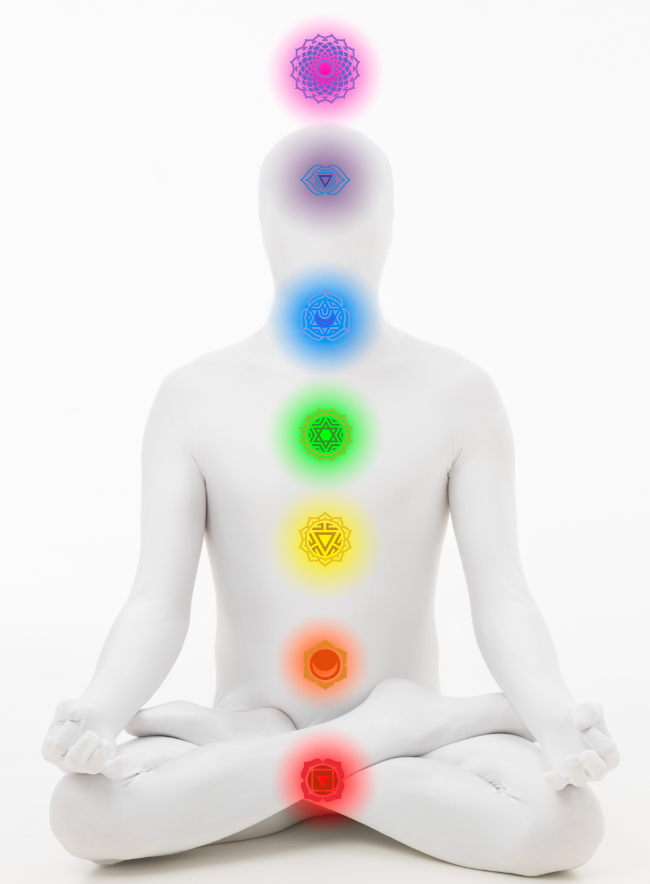If you’ve tapped into any sort of yoga or meditation, you may have heard mention of the chakra system in the body.
Of particular interest is the very first chakra – muladhara chakra, also known as the root chakra.
But what is the chakra system? And what do chakras have to do with your overall health and wellbeing?
The Chakra System

In a nutshell, the word chakra comes from Sanskrit for wheel. The chakra system consists of seven “wheels” of energy situated upon an energy circuit in your body. This main energy circuit runs from the base of the spine to the crown of the head.
Each chakra corresponds with different physical, mental, and spiritual aspects of your being.
Starting at the coccyx (base of the spine) the chakras are as follows:
- Root Chakra (Muladhara)
- Sacral Chakra (Swadhisthana)
- Solar Plexus Chakra (Manipura)
- Heart Chakra (Anahata)
- Throat Chakra (Vishuddha)
- Third-Eye Chakra (Ajna)
- Crown Chakra (Sahasrara)
When a chakra becomes blocked or imbalanced, it can impact your overall well-being. Fortunately, chakras can be brought back to equanimity through certain activities, meditations, and even objects.
This post will take an in-depth look at where it all begins – the Root Chakra.

Muladhara Chakra – the Root Chakra
Muladhara comes from the Sanskrit for mula (root) and adhara (base or foundation). The root chakra is the first of our energy centers to develop in utero and it forms the basis for our overall development. The spinal column develops from this base, and then the organs develop soon afterward.
The root chakra is often considered the most instinctual of the chakras. It does not involve much in the way of intellect and is “rooted” purely in survival. It is primal energy and the source of our fight/flight/freeze response.
Seen as the most animalistic chakra, muladhara chakra forms the border between animal and human consciousness. It is the most intensely linked to our unconscious mind and the foundation for the development of our personality.
It is also the place where we hold actions and experiences from the past.
What the Root Chakra Represents
At a purely physical level, muladhara chakra is associated with the adrenal glands, colon, kidneys, bones, muscles, and the arterial blood that flows through the left chamber of the heart and carries oxygen to our tissues.
As such, it is intimately connected with our motivation to eat, sleep, and procreate. It is the chakra of security, stability, and our basic needs. In other words, it comprises the aspects of your life that ground you, including food, water, and shelter – as well as your emotional needs of interconnection and feeling safe.
So it makes sense that the element associated with muladhara is earth, since it is the earth that provides us with food, shelter, and energy. And the color that corresponds with the root chakra is red, which symbolizes energy and moving, as well as the awakening of the sleeping consciousness to alert consciousness.
The positive qualities of the root chakra include vitality, vigor and growth. The negative attributes, however, are laziness, inertia, and being overly guided by physical desires. This is especially problematic when this chakra becomes imbalanced or blocked.
Imbalances in the Root Chakra
When muladhara is in balance, energy flows freely. We feel a sense of belonging and secure in our actions and choices. Concentration and clarity are improved and we have the ability to set goals and prioritize.

Imbalance, however, could be experienced as a lack of energy or, on the other end of the spectrum, restlessness and anxiety. It can show up as worry, frustration, resentment, and even anger or rage. Focus is difficult and thoughts are dominated by pessimism and negativity. These can lead to forming or returning to bad habits.
Physical imbalances can present in problems with the bladder, with elimination, or with lower back, leg, or feet issues.
Bringing Muladhara Back into Balance
Whenever one chakra is out of balance, it is likely to affect the others. It’s important to always start with balancing the root chakra.
Yoga and meditation are highly effective in balancing the chakras.

There are specific yoga postures that focus on restoring balanced energy to the root chakra. Lying on your back and bringing your knee to your chest is one of the most effective. Or sitting up with one leg extended and allowing your body to fold over that extended leg. These poses need to be performed on both sides. Other poses include a yoga squat, or sitting in a full lotus position.
Engaging mula bandha while practicing yoga will also help bring energy and strength back to this chakra. This is simply the act of consciously engaging the muscles one uses to restrict the flow of urine and keeping them engaged.
Meditation is also beneficial. Chanting or toning sounds during meditation can create vibrations in the body, and these vibrations help the cells work together in harmony. The mantra sound that corresponds to the root chakra is LAM (pronounced “lahm”).

Finally, many believe that the energy from certain gemstones can help bring chakras back into balance when placed on the area of the chakra. The best gemstones for muladhara chakra are red and they include include garnet, red jasper, and bloodstone.
Could You Benefit from Balancing Your Chakras?
The simple answer is yes. And in the coming weeks on this blog, we’ll continue to explore the other chakras, what they represent, and how to bring them into balance.
But these practices take time, patience, willingness, and guidance. Finding the time in your day to commit to this can seem impossible.

That’s why we’ve developed specific yoga/mindfulness/meditation programs that cater to your company’s, school’s, or organization’s needs.
Contact us today to find out how we can bring these practices to you – either in person or virtually. Bringing balance to your root chakra is just the beginning…



